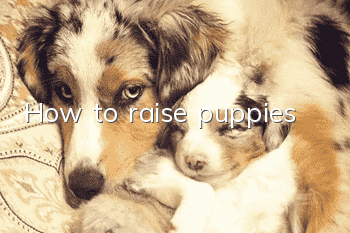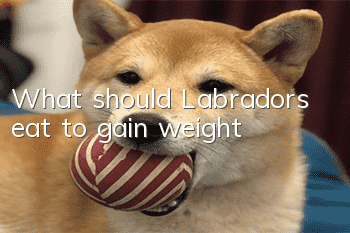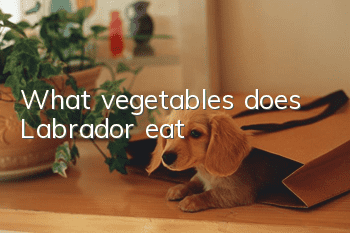How to raise puppies

Puppies spend the first two weeks after birth eating and sleeping, because newborn puppies have closed eyes and ears. The key to feeding is to let the female dog eat colostrum as soon as possible. Before feeding, the nipples should be washed, disinfected, and it is best to fix the nipples. Their energy is entirely supplied by their mother's milk, and they generally do not need additional supplementary food during this period. If the female dog cannot produce enough milk, such as the litter size is too large or the female dog dies, it must be artificially raised. It is best to find a foster mother for the puppies. Puppies that have lost their mothers have requirements in two aspects of life, namely a suitable environment and nutrients. In terms of management, the mother dog should be prevented from pressing on the puppies.
For puppies, the following two issues should be considered: ambient temperature and stimulation of urination and defecation.
Newborn puppies have sparse coats, less subcutaneous fat, and unstable body temperature regulation functions, so it is very important for puppies (especially in winter) to keep them warm. In order to maintain the ideal ambient temperature, an incubator can be used to control it at around 30°C, or a heating pad, infrared lamp or heater can be used in a properly isolated circle to increase the ambient temperature.
After feeding the puppies, the owner should use his fingers to imitate the action of the mother dog licking the puppies' anus-genital area with her tongue, and massage this area to stimulate the puppies to reflexively urinate, defecate, or Placing a piece of moist cotton wool on the anogenital area, or sliding a damp index finger along the abdominal wall, can also achieve the same effect. Puppies that are 16 to 21 days old can urinate and defecate on their own without stimulation.
From 28 days old, puppies can completely control their body temperature and begin to explore their surroundings, and become more independent. At this time, the puppies grow rapidly and their weight can reach twice that of birth within a few days. Therefore, the puppies need to eat a large amount of breast milk or breast milk substitutes (which should be appropriately controlled according to their digestion conditions). Substitutes must contain the various nutrients of breast milk.
As mentioned before, cow's milk and goat's milk cannot be directly used as breast milk substitutes for puppies, because the levels of protein, fat and calcium in these milks are too low as shown in the table above. The lactose and calcium in cat milk are not suitable for puppies, so they cannot be used as milk replacers. Many puppy milk replacers currently on the market are made based on milk and are more suitable for the needs of puppies. Puppies can be fed milk replacer with a small syringe or a special bottle for puppies. Dry milk products should be mixed with warm boiling water into liquid form and warmed (38°C) before feeding.
When feeding, you should move gently and slowly, and do not force the milk in. When feeding with a small bottle, the small hole on the nipple should be slightly enlarged so that the milk flow increases and air is not inhaled. Once the puppy begins to explore its surroundings, it is necessary to feed high-energy food, which can be combined with milk replacer at the beginning.Mix and serve separately later.
At the beginning of weaning of puppies (4 weeks after birth), the mother’s milk is the main source of nutrition for the puppies. At the same time, the puppy's digestive system also gradually begins to adapt to other new nutrients. During this period, puppies should be guided to eat soft and wet food, or even small grains of food soaked in warm broth or warm boiled water. Food with good palatability, high energy and high nutrition is most suitable for weaned puppies. After the puppies are completely weaned at 68 weeks of age, they will be separated from the mother dog and enter the growth stage. During this period, it is best to feed them four times a day without allowing them to eat freely.
In the management of puppies, attention should also be paid to getting more sun, especially in winter, sunbathing 2 to 3 times a day, and letting them exercise and comb their coat to promote blood circulation in the skin, grow hair faster, and enhance skin resistance. force. If you take a bath, be sure to dry the coat with a dry towel after washing, and then blow dry with a hair dryer.
German Shepherd puppies have small stomachs, so they must master the principle of eating small meals often. In the early stages of weaning, German Shepherd dogs should be fed more than four times a day. At around six months of age, feedings should be made three times a day. As age increases, feeding is gradually reduced to twice a day.
Each time you feed, you must control the portion and do not let your puppy eat too much. Try not to feed puppies food that is eaten by humans. Puppies have very simple requirements for food, and they will devour everything that comes to them. After a puppy gets used to eating some things that people eat, it will become dependent on what people eat. Because the nutrients in what people eat are different from the nutritional needs of puppies, the result will be uneven nutrient absorption and affect the puppy's development.
In addition to taking care of food, when raising German Shepherd puppies, you should also pay attention to its environment. When the weather is good, take the dog to do some activities in the yard, and do not go out unless the dog has received vaccines or something. Everything is ready. Its kennel should be kept clean and hygienic, and it should be exposed to the sun frequently. Ultraviolet rays can kill viruses.
Vaccine and deworming work:
28 days after birth: first deworming for internal parasites.
30 days after birth: the first dose of the two-part vaccine.
50 days old or older: the second dose of the six-part vaccine.
58 days old or older: Second round of deworming for internal parasites.
70 days old or older: The third dose of the six-combination vaccine.
88 days old or older: Second round of deworming for internal parasites.
To get the rabies vaccine, you must go to a regular hospital. You must not take the puppy out until 4 months after the puppy returns home.
- What are the feeding precautions for Akita puppies?
- How to judge the appearance of Akita puppies
- What should you pay attention to when raising golden retrievers?
- What is the best food for Labrador dogs?
- What is the best dog food to eat in Alaska?
- What should Labradors eat to make them grow faster?
- What to feed golden retriever dogs
- What are the precautions for German Shepherd bathing?
- Characteristics of Papillon puppies
- What are the precautions for epidemic prevention in Demu?



